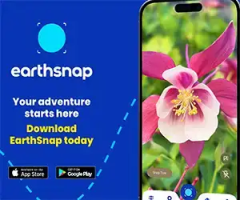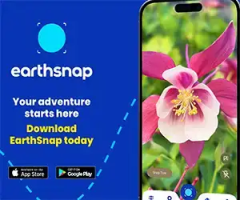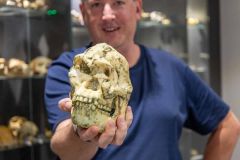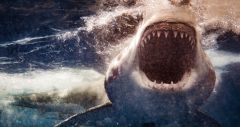Biology

Dec 18th, 2025 - Follow Earth on Google About 68-million-years ago, during the Late Cretaceous, a giant fossil egg was laid in Antarctica. The excavated remains reveal that a huge marine reptile laid eggs instead of giving birth to live offspring, as scientists originally assumed. Nicknamed "The Thing," the fossil egg measures about 11-inches long and 8-inches wide and was uncovered on Seymour Island. Those measurements make it the largest soft-shelled egg ever found and the second largest egg from any ... [Read More]
Source: earth.com

Dec 18th, 2025 - Imagine a healthy forest, home to a variety of species: Birds are flitting between tree branches, salamanders are sliding through leaf litter, and wolves are tracking the scent of deer through the understory. Each of these animals has a role in the forest , and most ecologists would argue that losing any one of these species would be bad for the ecosystem as a whole. Unfortunately – whether due to habitat loss , overhunting or introduced species – humans have made some species ... [Read More]
Source: theconversation.com

Dec 18th, 2025 - Follow Earth on Google In forests and fields across the world, some fungi quietly spread across land and live for centuries while their cells keep dividing and repairing damage normally caused by mutations. New research in the Netherlands suggests that some long-lived mushroom forming species use a genetic checkpoint that blocks harmful mutations. In some forest fungi, DNA analysis shows that one underground individual fungus starting from a single spore can stretch across hundreds of acres and ... [Read More]
Source: earth.com

Dec 18th, 2025 - Nautilus Members enjoy an ad-free experience. . A lone in a canoe, Val Plumwood was gliding along a channel in tropical Australia's Kakadu National Park in 1985 when a huge crocodile rammed her. She paddled to the shore as fast as she could, but the crocodile struck the canoe again and again. A thought flashed through Plumwood's mind: "I am prey." She grabbed hold of an overhanging tree, hoping to escape onto land. Nautilus Members enjoy an ad-free experience. "Before my foot even tripped the ... [Read More]
Source: nautil.us

Dec 18th, 2025 - Follow Earth on Google Chromosomes are the packages that hold DNA, and different animals have different numbers of them. Octopuses, squid, and cuttlefish are closely related, yet they don't match at all. Vampire and other squid and cuttlefish have around forty-six chromosomes, while octopuses have only about thirty. For a long time, scientists didn't know how this big difference came to be, or which group changed first. A new study now brings that history into view, revealing how this species ... [Read More]
Source: earth.com

Dec 18th, 2025 - A tiny amphibian highlights how much biodiversity still hides in Brazil's mountains. In the mountains of southern Brazil, a frog just over a centimeter long lives in the leaf litter of the forest floor. It is bright orange, active during the day, and easy to overlook. Until recently, it had no name. Now scientists have formally described it as a new species: Brachycephalus lulai , a pumpkin toadlet found only in a small stretch of cloud forest in the Serra do Quiriri, in Santa Catarina. The ... [Read More]
Source: zmescience.com

Dec 18th, 2025 - Follow Earth on Google A massive predator's tooth turned up in North Dakota, a place better known for dinosaurs than sea monsters. The discovery raised eyebrows right away. Mosasaur fossils usually come from ocean sediments. These reptiles were built for life at sea, patrolling ancient waters during the age of dinosaurs. Finding one inland is not just unusual. It feels almost wrong. What makes this discovery even stranger is where the tooth was found. It came from a river deposit, mixed in with ... [Read More]
Source: earth.com

Dec 17th, 2025 - The idea began in California's Sierra Nevada, a towering spine of rock and ice where rising temperatures and the decline of snowpack are transforming ecosystems, sometimes with catastrophic consequences for wildlife. The prairie-doglike Belding's ground squirrel ( Urocitellus beldingi ) had been struggling there as the mountain meadows it relies on dry out in years with less snowmelt and more unpredictable weather. At lower elevations, the foothill yellow-legged frog ( Rana boylii ) was also ... [Read More]
Source: theconversation.com

Dec 17th, 2025 - Nautilus Members enjoy an ad-free experience. . O striches, kiwi birds, and penguins are among the tiny sample of birds that can't lift their wings (or flippers) and fly. Now, scientists have identified a feathered dinosaur that also seems to have lacked this skill. Nautilus Members enjoy an ad-free experience. This creature belongs to a lineage of feathered dinos called pennaraptorans, who came onto the scene around 160 million years ago. They're distant ancestors of today's birds, and the ... [Read More]
Source: nautil.us

Dec 16th, 2025 - New research suggests the famous Little Foot fossil may belong to a previously unknown hominin species. When paleoanthropologists finally freed the skeleton called Little Foot from its stone prison in South Africa, they believed they were meeting an old acquaintance. Instead, they may have uncovered a stranger. After decades of excavation and debate, a new analysis argues that Little Foot — one of the most complete hominin fossils ever found — does not belong to any known species. ... [Read More]
Source: zmescience.com

Dec 16th, 2025 - By now, I am sure you have heard of the infamous Megalodon. With films out like The Meg , it is hard to have never heard of this massive creature. It was said to be a gargantuan shark that ruled the world's oceans millions of years ago. Now, researchers and scientists have discovered that it was not the only giant in the ocean. Researchers recently found evidence of a monstrous shark that existed even before the infamous Megalodon. What Is The Monstrous Shark That Existed Before Megalodon? This ... [Read More]
Source: wideopenspaces.com

Dec 16th, 2025 - Hundreds of yards of dinosaur tracks with toes and claws have been found in the Italian Alps in a region that will host the 2026 Winter Olympics, authorities said Tuesday. "This set of dinosaur footprints is one of the largest collections in all of Europe, in the whole world," Attilio Fontana, head of the Lombardy region in northern Italy, said during a news conference. The tracks, which are over 200 million years old, were discovered in the Stelvio National Park, in an area between the towns ... [Read More]
Source: cbsnews.com

Dec 14th, 2025 - It's quick and easy to access Live Science Plus, simply enter your email below. We'll send you a confirmation and sign you up for our daily newsletter, keeping you up to date with the latest science news. It's a long-held idea that turtles can tuck their heads into their shells when threatened. But is it true? And is this protective trick why turtles the world over have shells today? The answer is that some types of turtles can, and others can't, experts told Live Science. And even though ... [Read More]
Source: livescience.com

Dec 13th, 2025 - Gov'ts agree to ban or restrict international trade in shark meat, fins, and other products. For the first time, global governments have agreed to widespread international trade bans and restrictions for sharks and rays being driven to extinction. Last week, more than 70 shark and ray species, including oceanic whitetip sharks, whale sharks, and manta rays, received new safeguards under the Convention on International Trade in Endangered Species of Wild Fauna and Flora. The convention, known as ... [Read More]
Source: arstechnica.com

Dec 12th, 2025 - What would you do if you were a hungry Pacific white-sided dolphin, salivating at the idea of sampling some salmon but resigned to the fact that the fish is too large to capture and swallow whole? You might, scientists say, team up with a killer whale. In August 2020, scientists tracking the behavior of nine northern resident orcas off the coast of British Columbia observed the killer whales seeming to coordinate with Pacific white-sided dolphins to more easily score some tasty fish. On ... [Read More]
Source: bostonglobe.com

Dec 12th, 2025 - It's quick and easy to access Live Science Plus, simply enter your email below. We'll send you a confirmation and sign you up for our daily newsletter, keeping you up to date with the latest science news. A new study reveals an unknown species of whiplash squid burying itself upside down in the deep sea — a first-of-its-kind behavior for cephalopods. Scientists have filmed a never-before-seen species of deep-sea squid burying itself upside down in the seafloor — a behavior never ... [Read More]
Source: livescience.com